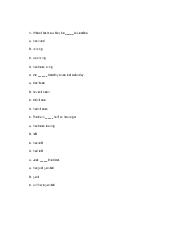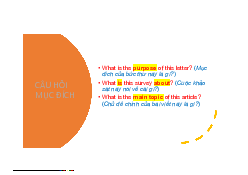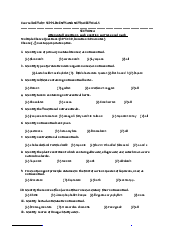




Preview text:
REVISION
Any list of the greatest thinkers in history contains the name of the brilliant physicist Albert
Einstein. His theories of relativity led to entirely new ways of thinking about time, space, matter,
energy, and gravity. Einstein's work led to such scientific advances as the control of atomic
energy, even television as a practical application of Einstein's work.
In 1902 Einstein became an examiner in the Swiss patent office at Bern. In 1905, at age 26, he
published the first of five major research papers. The first one provided a theory explaining
Brownian movement, the zig-zag motion of microscopic particles in suspension. The second
paper laid the foundation for the photon, or quantum, theory of light. In it he proposed that light
is composed of separate packets of energy, called quanta or photons, that have some of the
properties of particles and some of the properties of waves. A third paper contained the "special
theory of relativity" which showed that time and motion are relative to the observer, if the speed
of light is constant and the natural laws are the same everywhere in the universe. The fourth
paper was a mathematical addition to the special theory of relativity. Here Einstein presented his
famous formula, E = m(cc), known as the energy mass equivalence. In 1916, Einstein published
his general theory of relativity. In it he proposed that gravity is not a force, but a curve in the
space-time continuum, created by the presence of mass.
Einstein spoke out frequently against nationalism, the exalting of one nation above all others. He
opposed war and violence and supported Zionism, the movement to establish a Jewish homeland
in Palestine. When the Nazis came to power in 1933, they denounced his ideas. He then moved
to the United States. In 1939 Einstein learned that two German chemists had split the uranium
atom. Einstein wrote to President Franklind. Roosevelt warning him that this scientific
knowledge could lead to Germany developing an atomic bomb. He suggested the United States
begin its own atomic bomb research.
Question 1: According to the passage l, Einstein's primary work was in the area of
A. chemistry B. biology C. physics D. math
Question 2: Which of the following inventions is mentioned in the passage as a practical
application of Einstein's discoveries?
A. Radio B. Television C. Automobiles D. Computer
Question 3: According to the passage, Einstein supported all of the following EXCEPT A. nationalism
B. the establishment of a Jewish homeland in Palestine
C. atomic bomb research in the United States. D. the defeat of the Nazis.
Question 4: According to the passage in which country did Einstein live in 1930s?
A. Switzerland B. the United States C. Germany D. Israel
Question 5: The word “exalting” in the passage is closest in meaning to
A. criticism B. elimination C. support D. elevation
Question 6: It is clear from the tone of the passage that the author feels
A. Einstein's work in physics was somewhat tarnished by his conservative political views.
B. Einstein's work in physics, though theoretically impressive, led to few practical applications.
C. Albert Einstein was one of the most brilliant thinkers in history.
D. Einstein's theories have been consistently proven incorrect.
Question 7: According to Einstein, light is composed of separate packets of energy called
A. electrons B. photoelectrons C. gamma rays D. quanta
Passage 2: Read the following pasage and mark the letter A, B, C or D on your answer
sheet to indicate the correct answer to each of the questions
Garbage cans are not magical portals. Trash does not disappear when you toss it in a can. Yet, the
average American throws away an estimated 1,600 pounds of waste each year. If there are no
magic garbage fairies, where does all that trash go? There are four methods to managing waste:
recycling, landfilling, composting, and incinerating. Each method has its strengths and
weaknesses. Let's take a quick look at each.
Recycling is the process of turning waste into new materials. For example, used paper can be
turned into paperboard, which can be used to make book covers. Recycling can reduce pollution,
save materials, and lower energy use. Yet, some argue that recycling wastes energy. They believe
that collecting, processing, and converting waste uses more energy than it saves. Still, most
people agree that recycling is better for the planet than landfilling.
Landfilling is the oldest method of managing waste. In its simplest form, landfilling is when
people bury garbage in a hole. Over time the practice of landfilling has advanced. Garbage is
compacted before it is thrown into the hole. In this way more garbage can fit in each landfill.
Large liners are placed in the bottom of landfills so that toxic garbage juice doesn't get into the
ground water. Sadly, these liners don't always work. Landfills may pollute the local water supply.
Not to mention that all of that garbage stinks. Nobody wants to live next to a landfill. This makes
it hard to find new locations for landfills.
Compositing is when people pile up organic matter, such as food waste, and allow it to
decompose. The product of this decomposition is compost. Compost can be added to the soil to
make the soil richer and better for growing crops. While composting is easy to do onsite
somewhere, like home or school, it's hard to do after the garbage gets all mixed up. This is
because plastic and other inorganic materials must be removed from the compost pile or they will
pollute the soil. There's a lot of plastic in garbage, which makes it hard to compost on a large scale.
One thing that is easier to do is burning garbage. There are two main ways to incinerate waste.
The first is to create or harvest a fuel from the waste, such as methane gas, and burn the fuel. The
second is to burn the waste directly. The heat from the incineration process can boil water, which
can power steam generators. Unfortunately, burning garbage pollutes the air. Also, some critics
worry that incinerators destroy valuable resources that could be recycled.
Usually, the community in which you live manages waste. Once you put your garbage in that
can, what happens to it is beyond your control. But you can make choices while it is still in your
possession. You can choose to recycle, you can choose to compost, or you can choose to let
someone else deal with it. The choice is yours.
Question 1: Which of the following serves as the best title for this passage?
A. The Magic of Recycling: Bringing Back What Was Once Lost
B. Recycling, Landfilling or Composing: Which is Best for You?
C. Do Your Part How to Save the Earth by Recycling and Composting.
D. Methods of Waste Management: Advantages and Disadvantages
Question 2: According to the passage all of the following are mentioned as an issue with landfilling EXCEPT that A. landfills are smelly
B. landfills may pollute the water supply
C. it is difficult to find locations for landfills
D. usable materials are wasted in landfills
Question 3: What does the word “stinks” in paragraph 3 mean?
A. smells unpleasant B. seems dirty C. looks attractive D. feels soft
Question 4: Which of the following best explains why composting is not feasible on a large scale?
A. People wouldn't want to touch all of that gross rotting food.
B. Plastic would get into the compost and turn it into a pollutant.
C. It would smell too bad in densely populated cities.
D. It would attract rodents that would spread disease.
Question 5: According to the passage which of the following best defines “incineration”?
A. buying waste materials in a large hole
B. allowing waste products to decompose and become fertilizer
C. turning waste materials into products like book covers
D. burning waste materials and harvesting the energy
Question 6: The word “it” in the last paragraph refers to
A. community B. garbage C. waste D. possession
Question 7: According to the passage how many main ways to incinerate waste? A. one B. three C. two D. four
Question 8: Which conclusion could be drawn from the passage?
A. Recycling is without a doubt the best way to handle waste.
B. Each method of waste management has its drawbacks.
C. Incineration is the best way to process waste.
D. All large cities should create massive compost pile
Passage 3. Read the following passage and mark the letter A, B, C, or D on your answer
sheet to indicate the correct answer to each of the questions
Since water is the basis of life, composing the greater part of the tissues of all living things, the
crucial problem of desert animals is to survive in a world where sources of flowing water are
rare. And since man’s inexorable necessity is to absorb large quantities of water at frequent
intervals, he can scarcely comprehend that many creatures of the desert pass their entire lives without a single drop.
Uncompromising as it is, the desert has not eliminated life but only those forms unable to
withstand its desiccating effects. No moist- skinned, water-loving animals can exist there. Few
large animals are found. The giants of the North American desert are the deer, the coyote, and the
bobcat. Since desert country is open, it holds more swift-footed running and leaping creatures
than the tangled forest. Its population is largely nocturnal, silent, filled with reticence, and ruled
by stealth. Yet they are not emaciated.
Having adapted to their austere environment, they are as healthy as animals anywhere else in the
word. The secret of their adjustment lies in the combination of behavior and physiology. None
could survive if, like mad dogs and Englishmen, they went out in the midday sun; many would die in a matter of minutes.
So most of them pass the burning hours asleep in cool, humid burrows underneath the ground,
emerging to hunt only by night. The surface of the sun-baked desert averages around 150
degrees, but 18 inches down the temperature is only 60 degrees.
Question 1: The author mentions all the following as examples of the behavior of desert animals EXCEPT
A. they are watchful and quiet B. they sleep during the day
C. they dig home underground D. they are noisy and aggressive
Question 2: We can infer from the passage that
A. healthy animals live longer lives B. living things adjust to their environment
C. desert life is colorful and diverse D. water is the basis of desert life
Question 3: According to the passage, creatures in the desert
A. are smaller and fleeter than forest animals
B. are more active during the day than those in the tangled forest
C. live in an accommodating environment
D. are not as healthy as those anywhere else in the world
Question 4: The phrase “those forms” in the passage refers to all of the following EXCEPT
A. moist-skinned animals B. many large animals
C. water-loving animals D. the coyote and the bobcat
Question 5: The word “them” means
A. animals B. minutes C. people D. water
Question 6: The word “emaciated” in the passage mostly means
A. wild B. unmanageable C. cunning D. unhealthy
Question 7: Man can hardly understand why many animals live their whole life in the desert, as
A. water is an essential part of his existence
B. very few large animals are found in the desert
C. sources of flowing water are rare in a desert
D. water composes the greater part of the tissues of living things
Question 8: The title for this passage could be
A. “Man’s Life in a Desert Environment” B. “Desert Plants”
C. “Animal Life in a Desert Environment” D. “Life Underground



